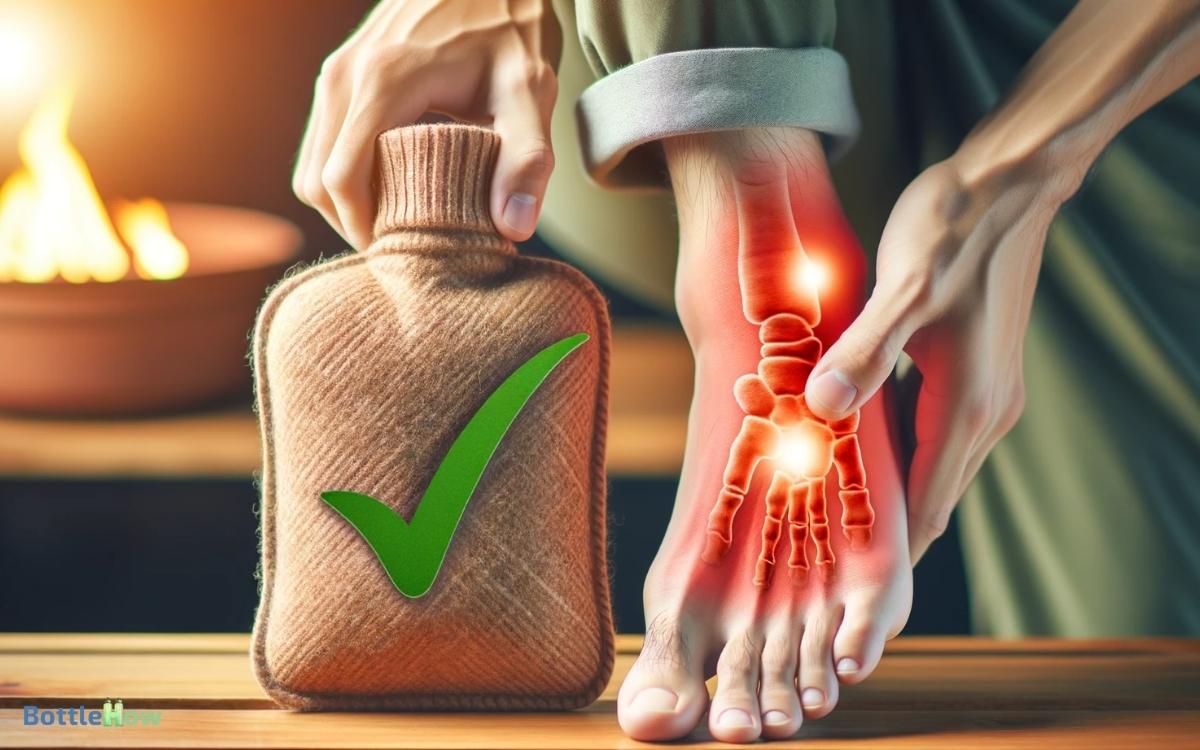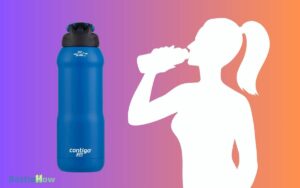Does Hot Water Bottle Help Gout? Find Out Here!
Utilizing a hot water bottle can help alleviate gout symptoms by increasing blood flow and promoting muscle relaxation.
This heat therapy aids in reducing joint pain and stiffness, potentially providing temporary relief during a flare-up.
While it’s effective for easing discomfort, it’s important to use a protective cover, maintain a safe water temperature, and avoid prolonged exposure to prevent burns.
For thorough gout management, combining heat application with medications, dietary adjustments, and proper hydration is essential. There are additional strategies you might find beneficial to fully address gout’s intricate nature.

Key Takeaways
Understanding Gout
Gout is a form of inflammatory arthritis characterized by the sudden onset of severe pain, redness, and swelling in the affected joints.
It primarily results from the accumulation of monosodium urate crystals, which form when uric acid levels in the blood become excessively high.
Uric acid is a waste product derived from purines, substances found in various foods and drinks. When your body either produces too much uric acid or fails to excrete enough, crystals can deposit in the joints, triggering intense inflammatory responses.
This condition often affects the big toe but can involve other joints such as the knees, ankles, or wrists.
Understanding the underlying mechanisms of gout is essential for effective management and treatment strategies.
Common Gout Symptoms
You’ll often notice symptoms of gout starting with joint swelling and intense pain, usually in the big toe.
Redness and tenderness often accompany these symptoms, making the affected area extremely sensitive.
Limited joint mobility can also occur, greatly impacting your daily activities.
Joint Swelling and Pain
Joint swelling and pain, hallmark symptoms of gout, result from the accumulation of uric acid crystals in the affected joints.
This crystalline buildup triggers an inflammatory response, causing noticeable swelling and intense pain.
You might experience these symptoms suddenly, often at night, and they can severely limit joint mobility.
Studies show that the big toe is commonly affected, but other joints like the ankles, knees, and hands can also be involved.
The pain can become so severe that even the weight of a bedsheet feels unbearable. Understanding the mechanisms behind this inflammation is vital for managing gout effectively.
Addressing these symptoms promptly can prevent long-term joint damage and improve your quality of life.
Redness and Tenderness
Almost invariably, redness and tenderness accompany gout flare-ups, indicating the intense inflammation at the affected joint.
As urate crystals accumulate, your body’s immune response triggers this inflammation, making the skin over the joint appear red and feel sensitive to touch.
The redness results from increased blood flow to the inflamed area, while the tenderness is due to the activation of pain receptors by inflammatory molecules like cytokines. Recognizing these symptoms early can help you manage gout more effectively.
Applying a hot water bottle may provide some temporary relief by promoting blood flow and reducing muscle stiffness, but it’s essential to also address the underlying inflammation through appropriate medications and lifestyle changes for long-term management. However, using a hot water bottle for appendicitis is not recommended, as heat can potentially worsen inflammation and lead to complications. Instead, seeking medical attention promptly is crucial to prevent the condition from escalating. While a hot water bottle can be helpful for general muscle discomfort, relying on proper medical care is essential for serious conditions like appendicitis.
Limited Joint Mobility
Experiencing gout often leads to limited joint mobility due to the severe inflammation and swelling that restricts movement.
When uric acid crystals accumulate in your joints, they trigger intense pain and cause the affected area to become rigid. This rigidity hinders your ability to perform everyday activities, as the joints can’t function normally.
Studies indicate that the ankle, knee, and toe joints are particularly susceptible, often resulting in significant discomfort and reduced range of motion. You might find it hard to walk, bend, or even stand without experiencing sharp pain.
Traditional Gout Treatments
Traditional gout treatments often focus on managing pain and reducing inflammation through a combination of medication and lifestyle modifications.
You’ll likely be prescribed nonsteroidal anti-inflammatory drugs (NSAIDs) like ibuprofen or naproxen to alleviate acute pain. Colchicine is another option, reducing inflammation by inhibiting crystal formation in joints.
Doctors might also prescribe corticosteroids for severe cases.
Beyond medication, lifestyle changes are vital. You’ll need to avoid purine-rich foods like red meat and alcohol, as they can elevate uric acid levels. Staying hydrated helps flush out uric acid.
Regular exercise and weight management are also essential, as obesity can exacerbate gout symptoms.
Role of Heat Therapy
Utilizing heat therapy, such as a hot water bottle, can provide temporary relief for gout-related pain and inflammation by increasing blood flow and relaxing tense muscles.
Heat therapy works by promoting vasodilation, which allows for better circulation and alleviates discomfort.
Additionally, the soothing warmth can reduce muscle stiffness and enhance mobility in the affected joints. While not a cure, heat therapy may complement other treatments for gout.
| Benefit | Explanation |
|---|---|
| Increased Blood Flow | Enhances circulation to the affected area |
| Muscle Relaxation | Reduces tension and stiffness |
| Pain Relief | Provides temporary respite from discomfort |
| Complementary Treatment Option | Can be used alongside other gout therapies |
Always consult with a healthcare provider to confirm it’s suitable for your specific condition.
Benefits of Hot Water Bottles
A hot water bottle offers multiple benefits for managing gout symptoms, including pain relief and improved joint flexibility.
The application of heat can increase blood circulation, which facilitates the removal of inflammatory substances from the affected joint.
Additionally, the warmth helps to relax tense muscles around the joint, potentially reducing stiffness and making movement easier.
Using a hot water bottle can also diminish nerve sensitivity, thereby lowering the perception of pain.
It’s vital to apply the hot water bottle correctly to avoid burns and guarantee consistent heat distribution.
By integrating this simple tool into your gout management routine, you can achieve notable symptom relief and enhanced joint function.
How Heat Affects Gout
Applying heat to a gout-affected joint can significantly impact inflammation and pain levels by promoting increased blood flow and muscle relaxation.
When you apply heat, blood vessels dilate, allowing more blood to flow to the affected area. This increased circulation can help reduce the buildup of uric acid crystals, which are the root cause of gout.
Additionally, heat can relax the surrounding muscles, which might be tense due to pain, further alleviating discomfort.
However, it’s important to note that heat mightn’t be suitable during acute gout attacks, as it can potentially worsen inflammation. Instead, consider using heat during non-acute phases to manage chronic pain and stiffness.
Always consult your healthcare provider for personalized advice.
Research Findings
You’ll find that research indicates heat can alleviate pain by increasing blood flow and relaxing muscles. Studies also show that applying heat reduces inflammation associated with gout.
Consequently, a hot water bottle may offer symptomatic relief, though it doesn’t address the underlying causes.
Heat and Pain Relief
Numerous studies have shown that applying heat, such as from a hot water bottle, can help alleviate the pain associated with gout by increasing blood flow and reducing muscle tension.
Researchers have observed that heat application can relax the affected area, thereby decreasing the pain intensity.
When you apply heat, it can also disrupt pain signals sent to the brain, providing temporary relief.
Clinical trials have demonstrated that patients using heat therapy report lower pain scores compared to those who don’t. Additionally, the warmth helps in loosening stiff joints, which can improve mobility.
However, it’s vital to monitor the temperature to avoid burns. Always wrap the hot water bottle in a cloth to prevent direct skin contact.
Inflammation and Blood Flow
Recent research indicates that heat application, such as from a hot water bottle, can significantly reduce inflammation and enhance blood flow in gout-affected areas.
By applying heat, you may experience vasodilation, which is the widening of blood vessels, leading to improved circulation and reduced swelling.
The heat also facilitates the removal of inflammatory mediators, thereby decreasing joint inflammation.
Here are three benefits of using a hot water bottle for gout:
- Enhanced Blood Flow: Heat promotes vasodilation, increasing nutrient and oxygen delivery to the affected area.
- Reduced Inflammation: Improved circulation helps clear out inflammatory cells and mediators, decreasing swelling.
- Pain Alleviation: With reduced inflammation and better circulation, there’s a subsequent decrease in pain levels.
Understanding these mechanisms can help you manage gout symptoms more effectively.
Using a Hot Water Bottle Safely
When using a hot water bottle to manage gout symptoms, it’s crucial to follow safety guidelines to prevent burns and complications. Make sure the water temperature doesn’t exceed 104°F (40°C) to avoid skin damage.
Always use a protective cover or cloth wrap around the bottle to create a barrier between the hot surface and your skin.
Limit application time to 20 minutes per session to prevent overheating the affected area. Check the bottle for leaks before each use to avoid accidental scalding.
Additionally, never fall asleep with the hot water bottle in place as prolonged exposure can cause burns.
Following these precautions will help you safely alleviate gout discomfort without risking further injury.
Additional Gout Relief Tips
In addition to using a hot water bottle safely, you can also employ dietary adjustments and proper hydration to help manage gout symptoms effectively.
Evidence suggests that lifestyle modifications play an essential role in controlling gout flare-ups. Here are three practical tips:
- Stay Hydrated: Drink plenty of water daily to help flush out uric acid, reducing the likelihood of crystal formation in joints.
- Limit Purine-Rich Foods: Reduce intake of foods high in purines such as red meat, shellfish, and alcohol, which can elevate uric acid levels.
- Maintain a Healthy Weight: Obesity is a risk factor for gout. Losing weight through a balanced diet and regular exercise can lower uric acid levels and decrease the frequency of attacks.
Implementing these strategies can significantly alleviate gout symptoms.
Conclusion
Imagine your joints as a bustling city; during a gout attack, it’s like rush hour gridlock. Using a hot water bottle can be akin to traffic control, easing congestion and restoring flow.
Research shows that heat therapy can alleviate pain and improve mobility. Remember, while a hot water bottle can offer relief, it’s just one aspect of a thorough treatment plan.
Always consult your healthcare provider to tailor the best approach for your gout management.




